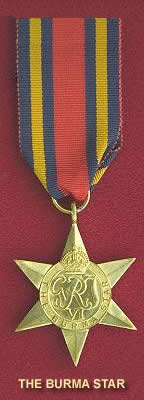
Credit To: The Commonwealth War Graves
Commission (CWGC) also I extend my courtesy to, The British War Memorial
Project (TBWMP). Without their kind permission of allowing access to their
databases, not to mention their loyalty and continued hard work, the roll
of honour would be sadly lacking. And for this we, THANK YOU!
The Commonwealth War Graves
Commission official website houses plans and images of the final resting
place of loved ones.
TAUKKYAN WAR CEMETERY |
Location Information:
Taukkyan War Cemetery is outside Yangon (formerly Rangoon), near the airport and immediately adjoining the village of Taukkyan. It is on PY1 road (formerly Prome Road), about 35 kilometres north of the city from which it is easily accessible. Historical Information: Note: |
KANCHANABURI WAR CEMETERY |
Location Information:
The town of Kanchanaburi is 129 kilometres North-West of Bangkok and is best reached by road, along the National Highway which runs north from the capital. There are bus and train services from Bangkok. Kanchanaburi War Cemetery is situated adjacent to Saeng Chuto Road which is the main road through the town. Historical Information: Note: |
MADRAS (ST. MARY'S) CEMETERY, CHENNAI |
Location Information:
Madras (St Mary's) Cemetery, Chennai, is 13 kilometres from Madras War Cemetery, 14 kilometres from the airport and 3 kilometres from the L.I.C. building. The route from the airport is along the Great Southern Trunk Road which passes Trident Hotel and crosses Kathipara Junction. From here follow Anna Road, which crosses Anna Fly Over, and goes, via L.I.C. building, towards Pallavan Selai. The entrance to St Mary's Cemetery is at the side of a Flyover and past the Pallavan Transport Office. From Madras Central Railway Station the route is up Mount Road and over the bridge which crosses the River Cooum. St Mary's Cemetery is situated about 1 kilometre from the Railway Station on Pellavanm Selai, formerly known as Bodyguard Road. The entrance to the cemetery is situated next to the Military E.H.E. Workshop. The Commonwealth plot is situated in the southern side of St Mary's Cemetery to the top left hand side of the main entrance. Historical Information: Note: |
MADRAS WAR CEMETERY, CHENNAI |
Location Information:
Madras War Cemetery is about 5 kilometres from the airport and 14 kilometres from the central railway station. The GST Road (Great Southern Trunk Road) leads from the airport past Trident Hotel to Kathipara roundabout - there is a Commonwealth War Graves Commission road direction sign on a small triangular island showing the way to the cemetery via Mount Poonamall Road, passing at the foot of St. Thomas Mount. The cemetery can easily be located on the right hand side of the road 1 kilometre from St. Thomas Mount. From Madras Central Railway Station the route is up Mount Road (Anna Selai) and over the bridge which crosses the River Cooun. The route passes St. Mary's Cemetery on Pallawan Road and is via LIC building (Life Insurance Corporation Building) situated on Mount Road, which leads to Anna Flyover and to Kathipara Junction. Historical Information: Note: |
MAYNAMATI WAR CEMETERY |
Location Information:
Maynamati is some 7 kilometres from the centre of Comilla, which is on the railway line linking Dhaka to Chittagong. It can be reached by train to Comilla railway station, 9 kilometres from the cemetery, or by the Dhaka - Chittagong highway. The cemetery is 1 kilometre down the road leading from Comilla to Sylinet and a short distance past the Cantonment Military Hospital. There is a C.W.G.C. road direction sign on a roundabout at the crossroad. Historical Information: Note: |
RANGOON WAR CEMETERY |
Location Information:
The cemetery is situated between Myienegone and Manthawaddy roundabout (close to the circle) and at the back of Burma Translation Society (Sarbaybeikmann). The entrance to the cemetery is down a lane facing east along PYI road (formerly Prome Road) some 8 kilometres from the port, 12 kilometres from the airport and 5 kilometres from the main railway station. There is no road direction sign to the cemetery, but Monasteries surround the cemetery on three sides. Historical Information: Note: |
RANGOON MEMORIAL |
Location Information:
The Rangoon Memorial is situated in Taukkyan War Cemetery, which is outside Yangon (formerly Rangoon), near the airport and immediately adjoining the village of Taukkyan. It is on PY1 road (formerly Prome Road), about 35 kilometres north of the city from which it is easily accessible. Historical Information: Note: |
RANCHI WAR CEMETERY |
Location Information:
Ranchi is a town in the State of Jharkhand, some 419 kilometres. north-west of Calcutta. It can be reached by air from Delhi, Kolkata and Patna. The War Cemetery is on Old Hazari Bagh Road, about 1.5 kilometres from Ranchi railway station. It is situated next to the SPG Christian cemetery near Kantatoli Chwok. The Cemetery entrance being several metres off the road can easily be missed, and few auto rickshaw drivers know the way. Visitors should contact their hotel manager for guidance. There is no residential cartaker on site and the gate is locked between 5pm and 8 am. During working hours the cemetery register can be obtained from one of the gardeners. Historical Information: Note: |
IMPHAL WAR CEMETERY |
Location Information:
Imphal, the capital of Manipur State, is in north east India and borders on upper Burma. The cemetery lies10km from the airport on the Imphal-Dimapur road (Highway 39) in the Deulahland district of the town. The small road leading to the cemetery is 1km along this highway on the right side, opposite the D M College. Historical Information: Note: |

The Burma Star
